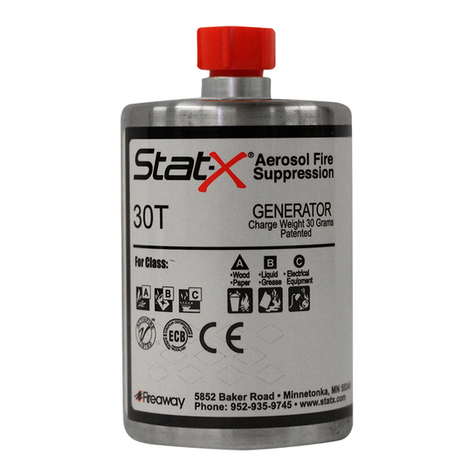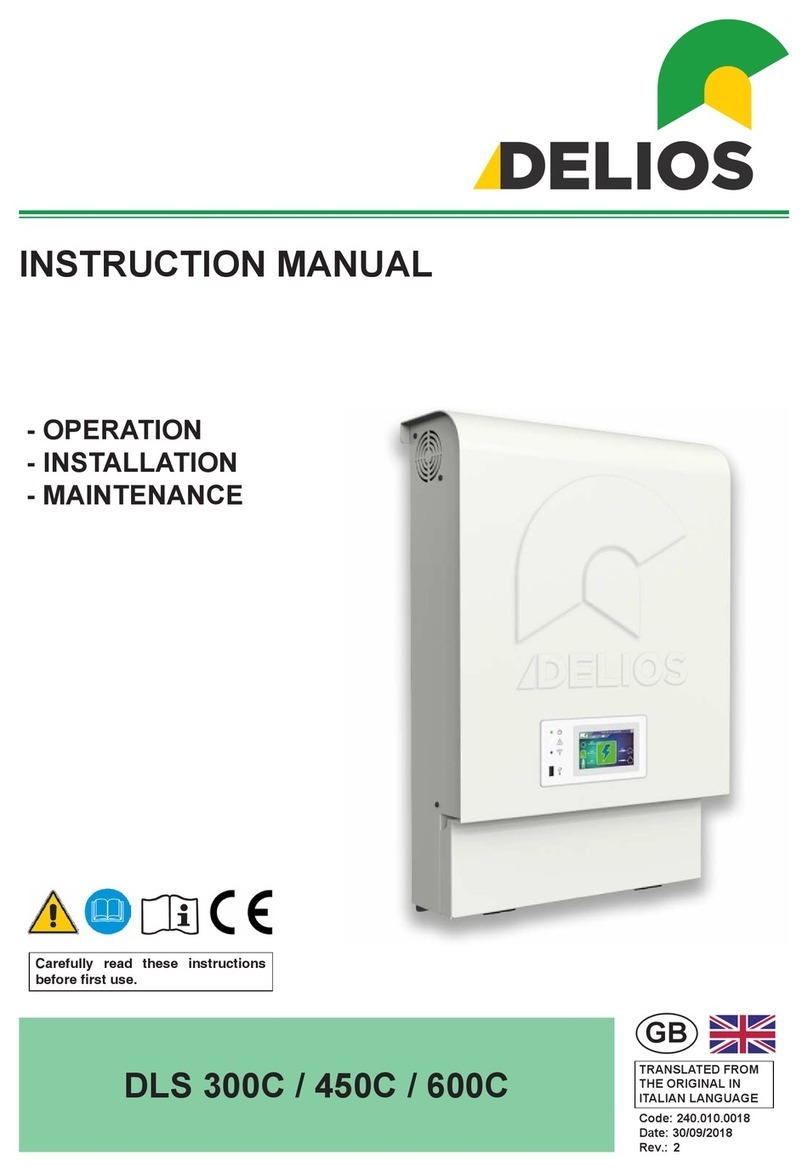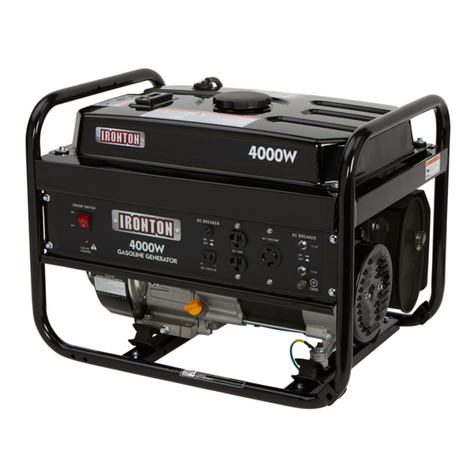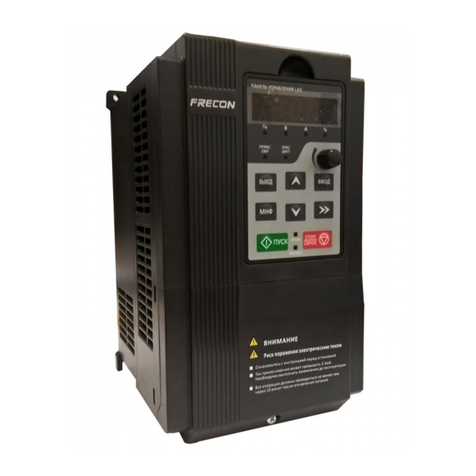GENERAL RADIO COMPANY 1391-B User manual


OPERATING INSTRUCTIONS
PULSE,
SWEEP,
AND
ME-
DELAY
GENERATOR
Form
9374
May,
1960
GENERAL RADIO COMPANY
WEST CONCORD, MASSACHUSETTS, USA

TABLE OF VOLTAGES AND RESISTANCES
(Cont.)
CHANGE NOTICE
for
Operating Instructions for the
Type 1391
-B Pulse, Sweep, and Time-Delay Generator
(Form 937-D)
Please make the following corrections in your manual:
RES TO
GND
-
00
W
'
50k
'50k
50
50
50
50
s10k
>10k
5
5
5
DC DC
TUBE VOLTS RES TUBE VOLTS RES AC VOLTS
-
V502
1
620k POWER 1-2
11
5
115
6.7
page 2, paragraph 1.2.4, line 2: Delete "(30, Figure 1.1)"
V503
(6AV5GA)
V504
(6AV5GA)
V505
(6AV5GA)
V506
(6AV5GA)
V507
(6550)
V508
(6550)
L
page 2, paragraph 1.2.4, line 4: Delete "(31)."
page 10, paragraph 2.6j, line 2: change "SWEEP POS" to
read "SWEEP NEG."
7
8
1
3
5
8
1
3
5
8
1
3
5
8
1
3
5
8
3
4
5
8
3
4
5
8
pages 28, 29: Substitute new Table of Voltages and
Resistances.
pages 32 et seq: Note the following.Parts List changes:
-
24
-23
40
55
145
120
55
55
105
120
-195
-195
-175
-90
-235
-195
-155
-75
0
26
-175
-155
All Type COC-63 capacitors are changed to
Type COC-62.
GENERAL RADIO COMPANY
West Concord, Massachusetts
210k
330k
180k
750
600
6.8k
180k
750
600
6.8k
620k
51
840
5k
620k
51
840
5k
150
25k
890
600
October, 1960 Printed in USA
.-,
-26
26
-155
-155
V603
(OD3)
150
25k
890
600
V510
(OA2)
V511
(12BH7)
V601
(6AS7G)
V602
(6AK5)
7
2
5
6
7
8
1
4
5
7
1
2
3
6
7
8
1
2
3
4
5
6
1
2
5
6 145
0
145
-230
-315
-315
-
170
-340
-190
-340
145
-13
-7
145
-13
-7
225
455
300
225
455
300
145
145
225
250 15k
0
15k
620k
280k
135k
5
1
11.9k
51
11.9k
100
1.lM
25k
0.
1.1M
25k
180k
450
0
180k
450
0
43k
15k
180k
5.lk
-
2- 6
1-7
-
-
.-
PLlOl
T201
12-23
9-13
25-26
32-33
10-11
7-8
6-16
27
-
28
17-18
3
4
5
6
7
8
9
10
11
12
3-5
6.7
6.8
6.7
6.7
70
140
140
100
300
75
75
-150
-150

TABLE OF CONTENTS
Section 1 INTRODUCTION
................................
1
1.1 Purpose
.....................................
1
1.2 Description
...................................
1
Section 2 OPERATING PROCEDURE
...........................
7
2.1 General
.....................................
7
2.2 Auxiliary Equipment
................................
7
2.3
Initial
Control Settings
..............................
7
2.4 Synchronization Procedure
.............................
9
2.5 Delay Circuit
...................................
9
2.6 Sweep Circuit
...................................
10
2.7 Pulse-Generating Circuit
..............................
11
2.8 Use of the Pulse Source Driving Function Switch
...................
11
Section 3 CALIBRATION PROCEDURE
..........................
12
3.1 Introduction
...................................
12
3.2 Test Equipment
..................................
12
3.3 Calibration and Adiustment of Input Circuits
.....................
12
3.4 Delay Circuits
..................................
13
3.5 Sweep- and Pulse-Timing Adiustments
........................
14
3.6 Power-Supply Adjustments
.............................
15
Section 4 DETAILED CIRCUIT DESCRIPTIONS
......................
16
4.1 General
.....................................
16
4.2 Input Circuits
...................................
16
4.3 Delay Circuits
..................................
16
4.4 Coincidence Circuits
...............................
17
4.5 Sweep Circuits
..................................
18
4.6 Pul.se.Timing Circuits
...............................
19
4.7 Pulse-Generating Circuits
.............................
19
4.8 Power Supplies
..................................
20
Section 5 SERVICE AND MAINTENANCE
.........................
21
5.1 General
.....................................
21
5.2 Service
.....................................
21
....
5.3 Special Techniques for Trouble-Shooting Delay. Sweep. and Pulse-TimingCircuits 22
5.4 Setup Procedure for the Pulse Duration and Position Dial Assembly
...........
23
5.5 Trouble-Shooting Chart
...............................
23
5.6 Trouble-Shooting Procedure
............................
26
PARTS LISTSAND WIRING DIAGRAMS
..........................
31


TYPE
1391-5
PULSE,
SWEEP, AND TIME-DELAY GENERATOR
Section
1
INTRODUCTION
1.1
PURPOSE.
The Type 1391-B Pulse, Sweep, and Time-De-
lay Generator (Figure 1.1)
is
a versatile laboratory instrument
designed to generate (1) push-pull pulses, of durationsfrom0.025
psec to
1.1
sec and at repetition rates up to 250 kc; (2) linear
sweep voltages of durations from 3 psec to 0.12 sec; (3) time
delays from
1
psec to
1.1
sec; and (4) direct and delayed trig-
ger pulses, which can be used independently or to delay the ini-
tiation time of the sweep and main pulse relative to the input
driving signal. Transition times of the output pulses (0.015
psec rise time) are compatible with most present-day oscillo-
scopes. The internal sweep circuit makes possible the use
No.
-
Name
Type
-
1
TRIGGER SELECTOR 4-pos selector switch
of an inexpensive oscilloscope by direct connection to the de-
flection plates.
1.2
DESCRIPTION.
1.2.1 GENERAL. The Type 1391-B
is
available in either relay-
rack or bench mounting, and
is
housed in two units. The upper
unit shown in Figure
1.1
is
the generator itself, with all oper-
ating controls at the front panel. Below this unit
is
the power
supply, with the main POWER switch and pilot light.
1.2.2 CONTROLS. The following table lists the controls on the
front panel of the Type 1391-B Pulse, Sweep, and Time-Delay
Generator (index numbers refer to Figure 1.1):
Function
Selects direction of input-signal zero-crossing to produce di-
-
..
rect synchronizing signal, and provides for ac or dc coupling
of input signal.
2 TRIGGERING LEVEL Concentric rotary control Sets dc level at which input circuits trigger.
TIME DELAY
3 MICROSECONDS Continuous rotary control Determines interval between delayed and direct synchronizing
4 RANGE 6-pos selector switch pulses over the range from
1
psec to
1.1
sec.
5
COINCIDENCE GATE Continuous rotary control Determines duration of coincidence gate from
3
to 1000
DURATION psec.
6 COINCIDENCE Continuous rotary control Selects threshold at which coincidence driving signals will
SENSITIVITY produce delayed sync signals.
7
SWEEP TRIGGER 2-pos toggle switch Selects either direct or delayed sync signal to start sweep.
PULSE AND SWEEP
TIMING
8
SWEEP MULTIPLIER 5-pos selector switch Determine sweep duration from
3
to 120,000 psec in decimal
9 Sweep Duration 3-pos selector switch multiples of
3,
6, and 12 psec.
Selector
10 VERNIER Continuous rotary control Adjusts sweep duration by
*lo%
from nominal value.
11
PULSE DELAY 6-in. rotary control and dial Sets duration of pulse.
12 PULSE DURATION 4-in. rotary control and dial Sets pulse duration.
13 PULSE AMPLITUDE 10-position selector switch Sets pulse amplitude.
14 OUTPUT IMPEDANCE 5-pos selector switch Selects any one of five load resistances for pulse current
source.
15 PULSE START 3-pos selector switch Routes internally produced or externally applied triggering
STOP TRIGGERS signals to determine pulse duration.
16 RESET SWEEP AND 2-pos spring-return Provides artificial reset pulse to restore sweep and delay
DELAY toggle switch circuit action.
DEFINITIONS:
Terms used in this manual are defined as fol- erated within instrument are called gates to distinguish them
lows: DRIVES are input signals used to synchronize the genera- from the main pulse. Timing signals produced by the delay cir-
tor with external sources. SYNCHRONIZING signals are output cuit and occurring at
a
time indicated by the delay control set-
signals from the generator,used to synchronize the external sys- tings are called DELAYED. Timing signals occurring after start
tem to the generator. TRIGGERS are signals circulating within of sweep by a time indicated by PULSE DELAY settingarecalled
theinstrument to synchronizethevarious internal
circuits.PULSE STARTsignals,while those occurring afterSTARTby a timeindi-
is
generally the main output pulse; other rectangular waves gen- cated by the PULSE DURATIONsetting are called STOP signals.

GENERAL RADIO COMPANY
1.2.3 TERMINALS. The following terminals are on the front panel of the Type 1391-B Pulse, Sweep, and Time-Delay Generator
(index numbers refer to Figure 1.1):
No.
-
Name
-
17 PRF DRIVE
18 DIRECT SYNC OUT
COINCIDENCE DRIVE
19 POS
20 NEG
21 DELAYED SYNC OUT
PULSE
22 POS
23 NEG
24 D-C
GATE
25 NEG
26 POS
SWEEP
27 NEG
28 POS
29 START
30 STOP
Type
Binding post pair
Binding post pair
Binding post pair
Binding post pair
Binding post pair
Binding post pair and
coaxial connector
Binding post pair and
coaxial connector
Binding post pair
Binding post pair
Binding post pair
Binding post pair
Binding post pair
Binding post pair
Binding post pair
Function
To external prf-determining signal source.
To external device to be synchronized by direct pulse.
%
Positive or negative pulses to coincidence circuits.
To external device to be synchronized after delay interval.
Positive pulse output.
Negative pulse output.
Upon removal of link, permits insertion of d-c voltage to adjust
pulse d-c component.
Output of pulses occurring simultaneously with sweep.
Output of sawtooth signals of duration determined by SWEEP
controls.
Terminals at which are available internally generated pulse-
timing triggers or to which are applied external triggers to
time pulse, depending on setting of PULSE START STOP
TRIGGERS switch.
1.2.4 INDICATOR LAMPS. Also on the front panel are the DE-
LAY MONITOR lamp (30, Figure 1.1), which indicates the pres-
ence of delayed synchronizing pulses at the DELAYED SYNC
OUT terminals, and the SWEEP MONITOR lamp (311, which in-
dicates the presence of the sweep signal at the SWEEP output
terminals.
1.2.5 BASIC CIRCUITS.
1.2.5.1 Input Circuits. The input circuits produce direct trig-
ger signals and direct synchronizing signals from an input drive
signal. By means of the TRIGGER SELECTOR switch, either a
positive- or negative-going zero crossing of the input signal can
be selected to produce the direct trigger and the accompanying
direct synchronizing signal, available atthe DIRECTSYNC OUT
terminals. This switch also provides for ac or dc connection of
the input signal to the trigger circuits.
1.2.5.2 Delay Circuits. The delay circuits produce delayed
triggers and delayed synchronizing signals whose timeof occur
rence relative to the direct trigger
is
controlled by the DELAY
MICROSECONDS and RANGE controls over a total range of
1
psec to
1.1
seconds. The coincidence system, consisting of a
monostable coincidence-gate circuit and a gating amplifier of
adjustable sensitivity,
is
not used in "normal" operation (i.e.,
with the COINCIDENCE GATE DURATION and COINCIDENCE
SENSITIVITY controls at NORMAL settings). When the coin-
cidence system
is
used, two inputs are required to produce the
delayed synchronizing signal. The first operates the delay cir-
cuits through the input circuit PRF DRIVE terminals to open
the
coincidence gate; the second, a brief pulse fed into the COIN-
CIDENCE DRIVE terminals, will cause the formation of the de-
layed trigger and synchronizing signal only when the gate is
open.
1.2.5.3 Sweep Circuit. The sweep circuits are started by either
the direct or the delayed trigger, depending on the position of
the SWEEP TRIGGER switch. These circuits produce (1) a lin-
early rising waveform that attains an amplitude of 135 volts in
3,
6,
or 12 psec or decimal multiples thereof up to a maximum
time of 120,000 psec, and (2) a gate signal with the same dura-
tion as the sweep. There are three controls for the sweep cir
cuit: the 3, 6, or 12-psec switch, a SWEEP MULTIPLIER, and a
VERNIER, affording about *lo-percent variation of the sweep
duration. Outputs from the sweep circuits are SWEEP, positive
and negative, and GATE, positive and negative.
1.2.5.4 Pulse-Timing Circuits. These circuits are adjusted
by
the PULSE DURATION and PULSE DELAY controls, which de-
termine the formation times of the START and STOP triggers
relative to the sweep. These triggers are used to start and stop
the main pulse.
The pulses produced in the timing circuits are connected
through the PULSE START STOP TRIGGERS switch to the

TYPE
1391-9
PULSE, SWEEP, AND TIME-DELAY GENERATOR
START
=
%DIRECT
DEL.TRIG.
SYNC
1.2.5.5 Pulse Source Circuits. These circuits form a bistable
.
*
ing circuit, amplifier, and output cathode follower. The Schmitt
SWEEP TRIG.
NEG.
SWEEP
circuit
is
driven by the direct-coupled amplifier, and in turn
SWEEP
CIRCUITS
drives the direct-trigger pulse-forming circuit to produce the
direct triggers at ptf's to 500 kc. This direct trigger synchro-
NEG. GATE
nizes the remainder of the circuit erouDs within the instrument.
JL
I
0
POS. PULSE
STOP NEG. PULSE
0
system that responds to start and stop triggers generated either
internally or externally to produce the push-pull pulse of adjust-
DELAYED
able amplitude, with an adjustable output impedance.
:
0
SYNC
1.2.6 GENERAL CIRCUIT DESCRIPTIONS.
1.2.6.1 Input Circuits. (See Figures 1.3 a, b.) The input cir-
cuits consist of an input amplifier, Schmitt circuit, pulse-form-
7-
DELAY CIRCUITS
-
-
--
--
-
-
-
-
-
-
--
-
-
-
-
DIRTRIG.
I
1
I
PRF
DRIVE
OINCIDENCE
I;
SYSTEM
1
I
Figure 1.2. System
Block
Diagram.
COINC.
DRIVE
0
pulse-generating circuits. This switch, shown schematically in
Figure 1.2, will:
a. when in the INTERNAL (NORMAL) position, start and
stop the pulse at the time set on the DURATION and DELAY
controls. (In this position, marker pulses corresponding to start
and stop times are fed to the START and STOP terminals.)
b. when in the EXTERNAL position, provide for externally
generated pulses to start and stop the pulse.
c. when in the INTERNAL
+
EXTERNAL position, permits
the internallyproduced start and stop triggers to be added to ex-
ternally generated pulses to start and stop the pulse. Thus the
delay circuits and the pulse trigger circuits can be used simul-
taneously to produce a double pulse.
L
--------------
---A
-
8
It can be formed on whichever zero-crossing the user selects.
For sine- and square-wave inputs, the trigger-generating system
requires about 0.3 volt peak; for brief pulses of either polarity,
about
1
volt.
The sweep and delay circuits can be started simultaneous-
ly by the direct trigger, or the sweep circuit can be triggered by
the delayed trigger. These two modes of operation, selected by
the SWEEP TRIGGER switch, either make the delay and sweep
circuits completely independent or make use of the delay cir
cuit to delay the sweep with respect to the direct trigger.
The direct synchronizing signal
is
a 100-volt, I-psec posi-
tive pulse fed from a cathode follower to the DIRECT SYNC
OUT binding posts on the front panel. Lagging slightly behind
the direct trigger, it can be used to synchronize auxiliary equip-
ment such as oscilloscopes and counters. It can also be used to
initiate the main pulse when the pulse duration
is
to be deter
mined by the delay circuit (refer to paragraph 2.8.2).
When the generator is driven by a brief, rapidly rising in-
put pulse, there
is
a time delay of 0.4 psec between this pulse
and the direct synchronizing signal. This time delay permits (1)
Figure 1.3a.
Block Diograrn
of Input Circuits.
I
DIRECT TRIGGER TD
7
Y
n
DIRECT TRIGGER TO
-DELAY
PRF. POS. GOING DELAY CIRCUIT
DRIVE
--
TO SWEEP
CIRCUIT
-
PULSE
0.2115
DIRECT
CIRCUIT FORMING
+
SYNC
Figure 1.3b.
Time Relatian-
ships
in
Input Circuits.
0
DELAY
DIRECT
SYNC
-
o
AMP.& C.F.
*kyNc
LIMITER
0
UT
-
GOING
-
-
-
4
-
SWEEP
TRIGGER=
SWbTL4
DELAYED
DIRECT
\
DELAYED TRIGGER

GENERAL RADIO COMPANY
MICROSECONDS
DEL.RANGE DEL. CONTROL
DIRECT
I
I
I
TRIGGER DELAY DELAY
CONTROL
-+
SWEEP AMPLITUDE RESET
FROM
INPUT
'
STAR?
BISTABLE
GENERATOR COMPARATOR TRIGGER
AMPLIFIER
-
SYNC GATE
CIRCUITS STOP DELAY RESET TRIGGER
4
COINCIDENCE COINCIDENCE
GATE DURATION SENSITIVITY DELAY ED TRIGGER TO SWEEP
C
?-
3-1000pSEC COINCIDENCE DEL.SYNC
,
MONOSTABLE-
AMPLIFIER
L
TRIGGER
JL
"
AMP.
B
C.F.
GATE
I
COINC.
0
POS,
DRIVE
4
INVERTER
::?ti
1-
PANEL
Figure 1.4a. Block Diagram of Delay Circuits.
the establishment of an accurately predetermined minimumdelay,
and (2) the observation of the direct synchronizing signal on al-
most any oscilloscope triggered by the input signal.
1.2.6.2 Delay Circuits. (See Figure 1.4a.) The direct trigger
starts the delay circuit by opening the bistable gate. The open-
ing of thegate starts a sweep generator, which produces a rising
voltage whose slope
is
determined by an r-c circuit selected by
the DELAY RANGE control. The DELAY MICROSECONDS con-
trol, a. 10-turn potentiometer, provides a voltage reference foran
amplitude comparator. When the sweep voltage reaches the level
set by the delay control, the amplitude comparator operates a
reset trigger generator that closes the bistable gate.
The dial for the 10-turn potentiometer
is
calibrated linear-
ly in 1000 divisions so that the delay can be read with high in-
cremental resolution. Delay
is
direct-reading in microseconds,
with the basic range from
1
to
11
microseconds. A six-decade
range switch selects R-C time constants in the sweep generator
to produce multipliers from
1
to
lo5.
1.2.6.3 Coincidence System. A monostable coincidence gate,
adjustable from about
3
to1000 psec, is a part of the delay cir-
cuit. The reset trigger produced by the main delay circuit opens
this gate
1
psec to
1.1
second after the direct trigger. The co-
incidence gate permits time-selection operations. (See Figures
1.4b, c, and d.)
In normal operation, the opening of the coincidence gate
produces the delayed synchronizing signal (Figure 1.4b). How-
ever, with reduced sensitivity of the coincidence amplifier, the
circuit can no longer be operated by the opening of the coinci-
.dence gate alone, and the circuits are prepared for coincidence
operation. In this condition, during the intervals in which the
gate
is
open, the injection of a positive or negative pulse at the
appropriate COINCIDENCE DRIVE terminals will cause the co-
incidence amplifier to operate, resulting in the formation of the
delayed synchronizing signal and delayed trigger. While the co-
incidence gate
is
open, as many delayed synchronizing signals
and triggers will be produced as there are driving pulses to the
coincidence circuit (Figure 1.4~).
Multiple delayed synchronizing pulses can be produced by
means of the delay and coincidence circuits, as shown in Fig-
ure 1.4d. The delay circuit can divide the input prf by any num-
ber up to about 20, depending on the setting of the delay time
controls. Direct synchronizing pulses are fed to the
POS
COIN-
CIDENCE DRIVE terminal. Any direct synchronizing pulse that
exists while the coincidence gate
is
open will cause a delayed
synchronizing pulse to be generated.
1.2.6.4 Sweep Circuit. The sweep circuit (Figure 1.5a), similar
in form to the main delay circuit,consists of a bistable gate, a
sweep generator and amplitude comparator, and a reset trigger
amplifier, which produces the reset signal to close the gate. In
this system, however, the sweep generator
is
a "bootstrap* cir-
cuit. It consists of a pentode switching tube, which
is
turned
off by the sweep gate to start the sweep, a cathode follower
with a gain of nearly unity, a feedback diode, and a gated clamp
circuit to control the initial sweep voltage. The linearly rising
voltage waveform in this circuit
is
fed to the sweep-amplitude-
comparator kircuit, which switches when the sweep voltage
reaches a preset 135 volts to form the reset trigger. In addition,
the positive sweep voltage
is
fed (1) to the pulse-timingcircuit,
(2) to a cathode follower to provide positive sweep, and
(3)
through an inverter-cathode-follower to produce the negative
sweep. The bistable sweep gate drives
a
phase-splitter, produc-
ing a push-pull waveform at the gate outputterminals. The nega-
tive sweep at the output terminal drives a stage operating a
neon indicator lamp to show that the sweep circuits are oper-
ating.

TYPE 1391-B PULSE, SWEEP, AND TIME-DELAY GENERATOR
Figure
1.4b.
Delay-Circuit Timing, Coincidence
Circuit Set for Normal Operation.
DIRECT
t
SYNC.
&+
h
hhhh.~hLLLhhLh~
i
,I
;
I
+l
i
1-
+
4
I
I
DELAY RESET
TRIGGER
COINCIDENCE
GATE
DELAYED
SYNC
DELAYED
Figure 1.4~.
Timing of Multiple Pulses.
I I
Figure 1.4d. Time Rela-
tionships When Delay Cir-
cuit Is Used as a
PRF
Di-
vider. Coincidence Circuit
Driven by Direct Synchro-
nizing Pulse.
VL
I
I
I
Y
3MSEC. I
-T~
I
I
1
I
I
I
I
I
I
DIRECT(F~)-T~~
SYNC
DELAY
-
GATE.
POS.
GATE
NEG.
GATE
FROM
SWEEP
TRIGGER s'w"E;p
SWITCH
NEG
SWEEP
Figure 1.5a.
Block Diagram
of Sweep Circuits.
L
TIMINO CIRCUITS
INDICATOR
h
h
h
h
h
h
h
h
h
4
I
I
I I
-9.2~~-
II
I
I
.
;
,
I
I
,
.
,I
I
I
COINC. GATE
DIRECT
OR
I
I
DELAYED
TRIGGER
,
,
;
I
i
'
2
I
;I,
~~3~p~f.~
-I
i
8
I
I
I I
SWEEP AMPLITUDE
I35v
(NORMAL) COMPARATOR
Figure 1.5b.
Time Relationships
inthe Sweep Circuit.

GENERAL
RADIO COMPANY
1.2.6.5 Pulse-Timing Circuits. The sweep voltage operates two
amplitude comparators (Figure 1.6a). The comparator at the
lower voltage level produces the start trigger (Figure 1.6b),
whilethat atthehighervoltage produces thestop trigger. The d-c
control voltages for these comparators are set by the concentric
panel controls for pulse duration and pulse delay (Figure
1.7).
The triggers produced by the changes of state of the comparator
circuits are differentiated and fed through a pair of cathode fol-
lowers to the PULSE START STOP TRIGGERS switch, where
they are fed to the pulse generator circuit to time the pulse and
to the START and STOP panel terminals. When the PULSE
START STOP TRIGGERS switch
is
set to INTERNAL CIR-
CUITS (NORMAL), these triggers operate
a
pair of amplifier
stages, which shape them to drive the bistable multivibrator
circuit of the pulse source.
1.2.6.6 Main Pulse-Generating Circuits. (See Figure 1.6a.) The
START and STOP triggers operare a high-speed, bistable gate
circuit. This circuit drives a pair of amplifiers, which in turn
operate a pair of drivers for the output stage. The push-pull out-
put stage
is
a
pair of beam tubes used as a current source with
switched load resistors, across which the pulse of voltage
is
Figure 1.7. Close-up of Pulse-Delay and Duration Dials.
SWEEP
FR
V307
D.C.
Figure 1.60. Block Diagram
of
Pulse-Timing and Output Circuits.
DIRECT OR DELAYED
POS.
SWEEP
DURATION
t
Figure 1.6b.
Pulse Timing Diagram.

TYPE
1391-9
PULSE, SWEEP, ANQ TIME-DELAY GENERATOR
developed. The conducting output tube produces a current of ditional binding post normally grounded to the panel through a
150 ma. Screen voltage on this stage
is
varied to control pulse shorting link. Under these conditions the output pulses contain
amplitude. an a-c component negative with respect to ground. If the shorting
The output system is balanced, and the push-pull pulses link
is
removed, the d-c component of an external voltage (from
appear at coaxial connectors and parallel binding posts. The any low-voltage laboratory supply or battery able to furnish 150
low-potential side of the load resistors is connected to an ad- ma) can be varied by about +25 volts.
Section
2
OPERATING PROCEDURE
2.1
GENERAL. The Type 1391-B Pulse, Sweep, and Time-
Delay Generator can, for instructional purposes, be considered
four separate instruments. If a thorough familiarity with all con-
trols is neither desired or needed, study merely those paragraphs
that apply to the circuits being used, as listed below:
2.2
Auxiliary Equipment
2.3
Initial Control Settings
2.4
Synchronization
2.5
Delay Circuit
2.5.1
Normal Use
2.5.2
Time Selection
2.6
Sweep Circuit and Pulse Duration-Delay System
2.7
Pulse-Generatingcircuit
2.8
Use of the PULSE START STOP TRIGGERS
switch
2.2
AUXILIARY EQUIPMENT. A few auxiliary instruments
are usually needed as components of the external system.
First, a source of a timing waveform
is
needed to determine the
repetition rate of the pulser. This can be a simple audio-ultra-
sonic oscillator, such as the General Radio Type 1210-C unit
R-C Oscillator, Type 1301-A Low-Distortion Oscillator, Type
1302 Oscillator, or Type 1304-B Beat-Frequency Oscillator, or
it can be a crystal oscillator with frequency dividers to produce
anyfrequency
up
to the 100-200-kc region. More complex sources
of time-coherent pulses are needed for the time-selection opera-
tions describedin paragraph 2.5.2. For these operations a timing
generator such as the Tektronix Type
180,
Dumont Type 300 or
equivalent can be used.
Choice of oscilloscope will depend on the application. An
oscilloscopewith broadband video amplifier is,of course, neces-
sary to permit observation of short-duration pulses. In order to
view the output pulse without degradation of rise time or shape,
the pulse must be amplified with a bandwidth in excess of 20
Mc, or else the pulse must be presented by direct connection to
the oscilloscope deflection plates. Many applications,of course,
do not require that the ultimate rise times be attained, and for
these tests less complicated oscilloscopes can be used.
The waveforms shown in this section (Figures 2.1 through
2.7) are oscillograms taken directly from the screen of a Tek-
tronix Type55
1
oscilloscope. Throughoutthe followingsections,
the prf set by the timing oscillator will be 10 kc (100-psec peri-
od). The operator should at first keep the dial settings in the
delayand sweep circuits considerably less than this value. When
the delay or sweep-duration settings equal or exceed the period,
the oscilloscope patterns can become unstable or difficult to in-
terpret.
2.3
INITIAL CONTROL SETTINGS. Before turning the instru-
ment on, set the following controls as indicated:
Control Setting
TIME DELAY RANGE 10-100 psec 50-psec
TIME DELAY MICRO- 5.00
SECONDS
COINCIDENCE GATE NORMAL
-
3
psec
DURATION
COINCIDENCE SEN- NORMAL
SITIVITY
SWEEP TRIGGER DIRECT
TRIGGER SELECTOR POS GOING AC
TRIGGERING LEVEL CENTER
PULSE AMPLITUDE 10
CIUTPUT IMPEDANCE 50
PULSE DURATION 5.0 on center scale (50-psec pulse)
PULSE DELAY 0.5 on center scale (5-psec delay)
SWEEP MULTIPLIER 10 (60-psec sweep)

GENERAL RADIO COMPANY
FIGURE 2.1. 10-kc PRF, 2Opsec/cm
A. INPUT SIGNAL, TRIGGER
SELECTOR AT POSITIVE
B.
INPUT SIGNAL, TRIGGER
SELECTOR AT NEGATIVE
FIGURE 2.2. 10-kc PRF 40psec DELAY 2Opsec/cm
DIRECT SYNC
DELAY SYNC,
4Opsec
DELAY
POSITIVE SWEEP,
60psec
NEGATIVE PULSES, DELAY
20,
FIGURE 2.3. 100 kc PRF DELAYSET FOR 70psec
SWEEP SET FOR 30wsec
C. DIRECT SYNC PULSE
DURATION
20
FIGURE 2.4. DELAY SET FOR 72psec, PRF 100 kc FIGURE 2.5. PULSE PAIR, PRF 10 kc, DELAY 20psec
TRIPLE SWEEP AND PULSE BY DIRECT SYNC TO POS COlNC DRIVE
INTERNAL-MULTIPLE-PULSEMETHOD TOPRODUCEDOUBLE PULSE
A. DIRECT SYNC
B.
DELAY SYNC
C. SWEEP
D.
PULSE
A. DIRECT SYNC
B.
DELAYSYNC
C. SWEEP
D. PULSE

TYPE
1391-B
PULSE, SWEEP, AND TIME-DELAY GENERATOR
FIGURE
2.6.
A. POS SWP,
10
kc
60psec, lOpsec/cm
B.
NEG PULSE
50psec lOpsec/cm
C. START PULSE
D.
STOP PULSE
FIGURE
2.7.
MULT PULSING, EXTERNAL METHOD
(2Opsec/cm)
2.3
INITIAL CONTROL SETTINGS. (Cont)
Control Setting
SWEEP DURATION 6 60-psec sweep
pSEC
VERNIER 0
PULSE START INTERNAL (NORMAL)
STOP TRIGGERS
2.4
SY NCHRONIZATION PROCEDURE.
a. Connect an audio oscillator (output at least one volt) to
the PRF DRIVE binding posts, and set the oscillator for a fre-
quency of 10 kc.
b. Connect an oscilloscope (prepared to write at about 20
A.
10
kc
CIRECT SYNC PULSE
B.
100-kc
PULSES TO POS COJNC DRIVE
C. DELAYED SYNC
D.
6-psec
SWEEP (SWEEP TRIGGER SWITCH
I
IN DELAYED POSITION)
psecper division) as follows:
(1) Cbnnect the oscilIoscope ground to the ground of the
Type 1391-B.
(2) Connect theoscilloscope external synchronizing
ortrig-
ger input to the Type 1391-B DIRECT SYNC OUT.
(3) Set the oscilloscope to accept a positive-going exter
nal synchronizing signal.
(4)
Connect the oscilloscope vertical amplifier to the Type
1391-B PRF DRIVE binding posts.
c. Turn all equipment on. After a warm-up time of about a
minute, both neon indicators on the Type 1391-B should glow.
If either indicator does not light, flip the RESET switch to start
the sweep or delay circuit.
d. Adjust oscilloscope to give a stable presentation and ob-
serve the input waveform on the oscilloscope. It should appear
as shown in Figure 2.1A.
e. Set the TRIGGER
SELECTOR
switch to NEG GOING AC.
The oscilloscope pattern should change phase by about 180
degrees, and should appear as shown in Figure 2.lb.
f.
Connect the oscilloscope input to the Type 1371-B DI-
RECT SYNC OUT terminals and observe the 75-volt, 1.5-psec
positive synchronizing pulse. It should appear as shown in Fig-
ure 2.1C or 2.2A.
2.5
DELAY CIRCUIT.
2.5.1 NORMAL USE.
a. Leave the input circuits connected as in paragraph 2.4,
with the TRIGGER SELECTOR switch set for either positive- or
negative-going triggering. Input oscillator frequency should be
set at 10kc.
b. Move the oscilloscope vertical input to the DELAYED
SYNC OUT terminals. The positive delayed synchronizing pulse
should appear as shown in Figure 2.2A.
c. Move the TIME DELAY MICROSECONDS dial to 2.00 and
observe the motion of the delayed synchronizing pulse. It should
appear as in Figure 2.2B. Change the setting of the TIME DE-
LAY RANGE switch to 1-10 psec, and again observe the pulse.
d. Set the TIME DELAY RANGE switch to the 10-100-psec
range, and increase the MICROSECONDS dial setting from 5.00
to 11.00 (fully clockwise). This produces a delay of 110 psec.
If the delay indicator lamp goes out, flip the RESET switch to
start the delay.
e. Remember that the period set by the timing oscillator was
only 100 psec. The delay circuit is now "counting downy and
the output period from the delay circuit
is
5kc or 200 psec.
Figure 2.3 illustrates this principle.
f.
Return the DELAY MICROSECONDS dial to 5.00.
2.5.2 TIME SELECTION. There are two methods of using the
delay circuits for time selection. The method described in para-
graph 2.5.2.1 (Figure 1.4d) does not require an external timing
source, but uses the direct sync to produce internal multiple
pulses. The second method, described in paragraph 2.5.2.2, re-
quires the use of a timingpulsegenerator.

GENERAL
RADIO
COMPANY
2.5.2.1 Internal Multiple Pulse Method.
a. Connect an external audio oscillator (set for 10 kc) to
PRF DRIVE.
b. Set the TRIGGER SELECTOR switch to POS GOING
AC.
c. Set the COINCIDENCE SENSITIVITY control fully coun-
terclockwise.
d. Set the COINCIDENCE GATE DURATION control to 250.
e. Set the TIME DELAY RANGE switch to the 100 psec-l
msec range.
f. Set the TIME DELAY MICROSECONDS dial to 9.20.
g. Connect the oscilloscope vertical-amplifier input to the
DELAYED SYNC OUT terminals.
h. Set the oscilloscope writing rate at 200 psec per divi-
sion.
i.
Set the oscilloscope for internal positive sync (or exter-
nal positive sync and connect sync input to the Type 1391-B
DELAYED SYNC OUT).
j.
Connect a wire lead from the DIRECT SYNC OUT terminal
to the POS COINCIDENCE DRIVE terminal.
k. It may be necessary to advance the COINCIDENCE SEN-
SITIVITY control clockwise if the DELAY MONITOR lamp does
not come on when the SYNC and DRIVE terminals are connected.
1. The DELAY MONITOR lamp may go out when the TIME
DELAY MICROSECONDS dial
is
moved over each 100-psec.
point. The delay circuit can be started by means of the RESET
switch.
m. The oscilloscope pattern should be similar to that shown
in Figure 2.3B. A timing diagram showing the action of the in-
put and delay coincidence circuit
is
shown in Figure 1.4d, and
the action
is
explainedin paragraph 1.2.6.3. At this point it may
be necessary to readjust carefully the oscilloscope synchroniz-
ing controls to obtain a stable pattern since the waveform
is
complex.
2.5.2.2 Time Selection, with an External Timing Generator.
a. Connect a 1-kc (1000-psec) pulse output from the timing
generator(amplitude over10 volts) to the PRF DRIVE terminals.
b. Set the TRIGGER SELECTOR switch to SINGLE PULSE,
and for the appropriate-polarity.
c. Connect 100-psec pulse of either polarity from the timing
generator to the appropriate COINCIDENCE DRIVE terminals.
d. Connect the oscilloscope vertical-amplifier input to the
Type 1391-B DELAYED SYNC OUT terminals.
e. Connect the oscilloscope sync input to the PRF DRIVE
terminals.
f.
Set the oscilloscope synchronizing controls for the polar-
ity of the input pulse, and set the oscilloscope writing rate at
200 psec per division.
g. Set the TIME DELAY RANGE switch to the 100-psec
-
1-msec range.
h. Set the TIME DELAY MICROSECONDS dial to 5.50.
i.
Set the COINCIDENCE GATE DURATION control to 200.
j.
Increase the setting of the COINCIDENCE SENSITIVITY
control from
its
counterclockwise limit until the indicator lamp
glows.
k.
Experiment with the COINCIDENCE SENSITIVITY con-
trol to obtain maximum amplitude from the two delayed syn-
chronizing pulses thatappear. Note that all 100-psec pulses ap-
pear when the control
is
in the NORMAL (clockwise) position.
Correct setting should yield a pattern similar to that shown in
Figure 2.7C.
1.
The TIME DELAY MICROSECONDS and COINCIDENCE
GATE DURATION controls can now be varied to study the cir-
cuit action. The basic principles of operation of this circuit are
presented
in
paragraph 1.2.6.3, and Figure 1.4~shows an ideal-
ized time diagram illustrating the time selection system.
m. Now obtain two delayed synchronizing pulses (as in step
k), and move the oscilloscope vertical amplifier input connec-
tion to the SWEEP POS terminals.
n. With the SWEEP TRIGGER switch at DIRECT, note that
there
is
one 60-psec sweep sawtooth for each 1000-psec pulse
to the PRF DRIVE terminals.
o. Set the SWEEP TRIGGER switch to DELAYED, and note
that there
is
a sweep for each 100-psec timing pulse selected
(Figure 2.2D).
p. Repeat step 1,observing the sweepinstead of the delayed
synchronizing signals.
2.6
SWEEP
CIRCUIT
a. Set all controls to the positions given in paragraph 2.3.
b. Connect the prf drive oscillator, set at 10 kc to give a
100-psec time base, to the PRF DRIVE terminals.
c. Connect the oscilloscope vertical amplifier input to the
SWEEP POS terminals.
d. Connect the oscilloscope sync (or trigger) input to the
Type 1391-BDIRECT SYNC OUT terminals. Set the oscilloscope
for a positive synchronizing signal.
e. Set the oscilloscope writing rate to 20 psec per division.
f.
With all equipment on and warmed up, check that the DE-
LAY MONITOR and SWEEP MONITOR indicator lamps are on.
If either indicator does not glow, flip the RESET switch. If both
lamps still do not glow, recheck the control settings against
those given in paragraph 2.3.
g. Note that one 60-psec sweep
is
generated for each input
cycle. The oscilloscope pattern should appear as shown in Fig-
ure 2.2C.
h. Change the sweep duration to 30 by setting the SWEEP
DURATION pSEC control to 3 (with the SWEEP MULTIPLIER
switch still at 10). Then generate 3-, 6-, and 12-psec pulses by
setting the SWEEP MULTIPLIER switch to
1
and switching the
SWEEP DURATION pSEC control to
3,
6, and 12.
i.
Return the SWEEP MULTIPLIER switch to 10 and the
SWEEP DURATION pSEC switch to 6.
j.
Connect the oscilloscope vertical amplifier input to the
SWEEP POS, GATE POS, and GATE NEG terminals and ob-
serve the negative sweep and the positive and negative gates.
Then return the oscilloscope connection to the SWEEP POS ter-
minals.
k. Place the SWEEP TRIGGER switch in the DELAYED po-
sition to delay the start of the sweep 50 psec.
1.
Move the TIME DELAY MICROSECONDS dial to move the
sweep in time relative to the direct synchronizing pulse. The
delayed trigger may be lost
if
the delay setting exceeds 100
psec. If it
is
lost, flip the RESET switch.
m. If the sweep controls are set for a duration in excess of
100 psec, the sweep circuit will ignore the triggers that occur
daring sweep time and thereby reduce the sweep recurrence rate.
Observe this effect asdirected in steps n and o.

TYPE
1391-B
PULSE, SWEEP, AND TIME-DELAY GENERATOR
n. Set the SWEEP DURATION pSEC control to 12 and the
SWEEP MULTIPLIER to 10 to produce a 120-psec sweep. The
sweep recurrence rate is now 5 kc. If theSWEEPMONITORlamp
goes out, flip the RESET switch.
o. Reset the sweep controls for60 psec (SWEEP DURATION
pSEC to 6, SWEEP MULTIPLIER to lo), and vary the input tim-
ing frequency from 10 kc at the audio generator. Note that as
the frequency
is
increased toward 16 kc, the sweep becomes in-
stable. The vernier control can be set to either
f
or
-
10%to
restore stability.
2.7
PULSE-GENERATING CIRCUIT.
a. Set all controls to the positions listed in paragraph 2.3.
b. Connect the oscilloscope vertical amplifier input to the
PULSE POS terminals. If either brief pulses or a fast rise time
is
desired, use a coaxial cable for this connection.
c. Connect the oscilloscope ext sync to the Type 1391-B
DIRECT SYNC terminals.
d. Observe the output positive 50-psec pulse. Experiment
with the DELAY and DURATION controls, setting DELAY to 20,
DURATION to 20. The negative pulse should appear as in Fig-
ure 2.2D.
e. Move the oscilloscope connection to the PULSE POS ter-
minals and observe the positive 40-psec pulse.
f.
Reduce the pulse duration from 50 to 25 psec by switch-
ing the SWEEP DURATION pSEC control to
3.
Observe the
pulse duration and delay and return theSWEEP DURATION pSEC
switch to
6.
g. Reduce the pulse duration to 25 psec by resetting the
PULSE DURATION (inner) dial.
h. Reposition this 25-psec pulse to start 25 psec after the
sweep by rotating the PULSE DELAY dial counterclockwise.
Note that the three rings of numbers on the PULSE DURATION
-
and PULSE DELAY dials correspond to the three settings of the
PULSE SCALE switch.
i. Now pulses of 2.5 psec can be obtained with the SWEEP
MULTIPLIER switch set at
1.
Various other pulse durations and
delays can be set by means of the sweep switches, PULSE DU-
RATION, and PULSE DELAY controls.
j.
Short Pulses: Decrease the sweep duration to 3 psec.
Then decrease the PULSE DURATION setting until
sl
pulse of
minimum duration
is
produced. Note that this pulse can be re-
duced even beyond theusual amplitude, and that the pulse polar-
ity will reverse suddenly at a DURATION setting below zero.
This
is
characteristic, since it
is
not possible toproduce a me-
chanical stop of sufficient accuracy to stop the motion of the
DURATION dial at exactly zero.
DIRECT
SYNC
20Wf
i
1-0
START
DELAYED
SYNC
2?r~f
J
I
I
*
STOP
Figure
2.8.
Adding Network
for
Multiple Pulsing.
k. Set up a I-psec pulse and experiment with the OUTPUT
IMPEDANCE and PULSE AMPLITUDE controls. Some defects
might appear in the pulse due to impedance mismatch as the
OUTPUT IMPEDANCE setting
is
varied. Note also that the
PULSE AMPLITUDE control adversely affects the pulse shape
when thepulse
is
set to greatly reducedvalues. The PULSEAM-
PLITUDE control is generally satisfactory for pulses of long
duration and over a 10- or 20-db range, but for best pulse shape
an attenuator or a pad of the proper impedance
is
recommended.
2.8
USE OF THE PULSE START STOP TRIGGERS SWITCH.
2.8.1 INTERNAL (NORMAL) POSITION.
a. Set all controls to the positions listed in paragraph 2.3.
b. Set the oscilloscope horizontal controls for a writing rate
of 20 psec per division.
c. Connect the oscilloscope vertical amplifier input to the
PULSE NEG terminals.
d. Connect the oscilloscope sync to the Type 1391-B DI-
RECT SYNC terminals.
e. Observe the 50-psec negative pulse on the oscilloscope.
It should appear as shown in Figure 2.6B.
f. Now move the oscilloscope vertical input connection to
the START terminal. Note the presence of a 5-volt positive
start pulse corresponding to the leading edge of the main pulse
(Figure 2.6C).
g. Move the oscilloscope vertical input connection to the
STOP terminal, and note the presence of a 5-volt positive stop
pulse asshown in Figure 2.6D. Note at both START and STOP
terminals a negative pulse at the end of the sweep. Move the
PULSE DURATION dial and note the motion of the stop pulse
corresponding to the dial reading. The start pulse moves when
the PULSE DELAY dial is moved.
2.8.2 EXTERNAL POSITION.
a. Move the oscilloscope vertical input connection back to
the PULSE POS terminal, and, if possible, set the oscilloscope
for d-c input.
b. Set the PULSE START STOP TRIGGERS switch to the
EXT position.
c. Tap first the START and then the STOP terminal with a
piece of metal held in the hand. The pulse should start andstop
with each tap. In this manner, pulses can be produced by any ex-
ternal trigger generator.
d. To use the delay circuit to time the main pulse, proceed
as directed in steps e through h below.
e. Set the oscilloscope and PULSE START STOP TRIGGERS
switch as indicated in steps a and b abovz.
f.
Connect a jumper wire from the DIRECT SYNC OUT ter-
minal to the START terminal and another from DELAYED SYNC
to STOP terminal.
g. Note that a 50-psec pulse, corresponding to the 50-psec
delay interval,
is
produced (Figure 2.5B). Now vary the time
delay settings from
1
psec up to about 90 psec and note that
pulse duration
is
controlled by delay.
h. This connection,inwhich the delaycircuit
is
used to con-
trol pulse duration, permits the production of pulses up to
1.1
seconds in duration. To produce such a pulse, set (if possible)
the oscilloscope writing rate at 0.2 sec per division. Disconnect

GENERAL RADIO COMPANY
the driving oscillator from the PRF DRIVE terminals. Set the
TIME DELAY MICROSECONDS dial to 11.00, and the TIME
DELAY RANGE switch to 100 psec
-
1
sec. Now either flip
the RESET switch or tap the PRF DRIVE terminal quickly, and
note the production of the long pulse.
2.8.3 INTERNAL
f
EXTERNAL POSITION. This position per-
mits externally produced trigger pulses to be added to the start
and stop triggers generated in the pulse timing circuits. To test
the operation of this switch position, generate a double pulse as
follows:
a. Build and connect the adder circuit shown in Figure 2.8.
b. Set the SWEEP TRIGGER switch to DELAYED.
c. Connect the oscilloscope vertical deflection input to the
PULSE POS terminals.
d. Connect the oscilloscope synchronizing terminal to the
DIRECT SYNC OUT terminals.
e. Set the PULSE START STOP TRIGGERS switch to EX-
TERNAL and move the DELAY MICROSECONDS dial from its
standard position, noting that the delay circuit controls thedura-
tion of the pulse.
f. Set the PULSE START STOP TRIGGERS switch to IN-
TERNAL
f
EXTERNAL, with the pulse timing controls in stan-
dard positions. Note the presence of a double pulse. The delay
and duration of the second pulse can be varied by means of the
PULSE DELAY and DURATION controls.
Section
3
CALIBRATION PROCEDURE
3.1
INTRODUCTION.
Calibration and readjustment procedures
are given in the order of signal progression through the instru-
ment. Paragraph 3.2 lists the test equipment necessary to carry
out the calibration of the various circuits, and paragraphs 3.3
through 3.6 discuss the calibration and readjustment procedures
necessary in each circuit.
It is hardly likelythat a complete calibration, such asthat
given everynew instrument in the General Radio laboratory, will
ever be necessary. Usually few, if any, adjustments are neces-
sary when a tube or circuit component
is
replaced because of
failure. Gradualdegradation in tube characteristicswith use may
require retouching of the screwdriver adjustment common to all
ranges in the sweep or delay circuit. Also, some unpredictable
shift in the values of resistors or capacitors in range timing cir-
cuits will generally appear as a change in the calibration of one
range. Only the adjustmentfor thatrangemust be set,and onlythe
relevant paragraph must be consulted, along with paragraph 3.2.
A
common adjustment is the range minimum adjustment
(R238) in the delay circuit,which may require readjustment when
V203
is
replaced. This adjustment, discussed in paragraph 3.4,
is
common to all delay ranges. An equivalent adjustment may be
necessary in the sweep circuits to restore the calibration of the
pulse-delay dial when either V303 or V307
is
replaced. The con-
trols requiring readjustment are the pulse duration and delay
minimums R412 and R411. (Refer to paragraph 3.5.2.) Other ad-
justments are those used to correct for component tolerances in
the R-C time constants. Such adjustments must
be
made only
when the components themselves drift (unlikely) or are replaced.
3.2
TEST EQUIPMENT.
The type and quantity of auxiliary
test equipment necessary for recalibration depend entirely on
the accuracy desired, the complexity of the recalibration, and,
to some extent, on the range being recalibrated. This equipment
can range from a cathode-ray oscilloscope, audio oscillator, and
ac-dc multirangemeter to the fullseries of time-measuringequip-
ment listed below. The equipment listed below
is
adequate for
complete recalibration of the instrument.
(1) Oscilloscope
-
Tektronix 530 or 540 series, or equiva-
lent.
(2) Crystal-controlled time-marker generator
-
Tektronix 180,
Dumont 300, or equivalent producing time markers from
1
to
10,000 psec. All of these timing markers should be simultane-
ously available at the panel terminals of the marker generator.
(3) Time-interval measuring system
-
While not an absolute
necessity in the recalibration of the instrument, a time-interval
meter simplifies the calibration of the longer sweeps, delay in-
tervals, and pulse durations. This time-interval meter should
operate from two triggers, one to start and one to stop the time-
interval measurement. Ideally, it should resolve
1-
or 0.1-psec
input pulses. The time-interval meter will facilitate the measure-
ment of the longer delays, sweeps, and pulses, without the ne-
cessityof viewing the very slow transients arising from the long
delays on an oscilloscope. Possible instruments for use in this
application, if available, are the Berkeley 5571 and 5510, Hew-
lett-Packard 521-A, 522-B, or 524-B plus 526-B, or theLFE501.
Additional test equipment includes an audio oscillator
(General Radio Type 1210, 1302, or equivalent) needed to set
the prf, and an a-c vacuum-tube voltmeter to measure either the
rms or peak value of the input voltage.
3.3
CALIBRATION AND ADJUSTMENT OF INPUT CIRCUITS.
3.3.1 ADJUSTMENT OF R104.
a. Connect the audio oscillator (set to 10 kc, output atleast
1
volt) to the PRF DRIVE terminals.
b. Connect the oscilloscope vertical amplifier input to the
DIRECT SYNC OUT terminals.
c. Center the TRIGGERING LEVEL control.
d. Set the TRIGGER SELECTOR switch to POS GOING AC,
and observe the direct synchronizing signal as the audio oscil-
lator gain-control setting
is
decreased.

TYPE
1391-B
PULSE,
SWEEP, AND TIME-DELAY GENERATOR
e. Adjust R104 so that the direct synchronizing pulse
is
-
..
formed with minimum voltage input. With correct adjustment, the
input voltage will be less than 0.3 volt rms.
3.3.2 ADJUSTMENT OF C102.
a. Set the TRIGGER SELECTOR switch to POS GOING AC.
b.
Set the SWEEP TRIGGER switch to DIRECT.
c. Connect the oscilloscope probe to the center (output) ter-
minal of S203, the SWEEP TRIGGER switch.
d. Adjust C102 for a trigger amplitude of 5 to 6 volts peak-
to-peak.
3.4
DELAY
CIRCUITS.
3.4.1 ADJUSTMENT OF THE TIME DELAY MICROSECONDS
DIAL MINIMUM AND MAXIMUM. This adjustment should be ne-
cessaryonlywhen eitherV203, V204, or V205 has been replaced.
The time delay between the direct and delayed synchronizing
pulses must be measured accurately, and should be within 0.3
percent.
There are three different ways to measure the time delay
between the direct and delayed synchronizing pulse. The first
two ways require the use of only the high-speed oscillograph
and the precision time-marker generator. The third method, most
convenient for the three longer delay ranges, requires the use of
the time-interval measuring device (refer to paragraph 3.2).
3.4.1.1 First Method. In this method, the time-marker generator
is
used to set the prf of the Type 1391-B at a rate considerably
slower than the period corresponding to the delay range to be
checked. A second output from the time-marker generator
is
pre-
sented to calibratethe oscilloscope sweep. An electronic switch
that will simultaneously present the delayed synchronizing sig-
nal and the timing markers to the oscilloscope
is
recommended.
Timing markers can also be presented if they are placed on the
oscilloscope gate input terminals either to brighten or to blank
the oscilloscope sweep to displaythe marker interval. The posi-
tion of the direct synchronizing pulse relative to the timing
markers
is
carefully determined and the oscilloscope probe
is
moved to the DELAYED SYNC terminal. The delay dial calibra-
tion can then be checked at the cardinal points represented by
the timing markers. This procedure
is
the only effective means
for calibration of the lower two delay ranges, 1-10 and 10-100
psec.
3.4.1.2 Second Method. In the second method, the timing-mark-
er generator
is
used to set the prf of the Type 1391-B as in the
first method, but the higher-frequency timing markers corres-
ponding to the cardinal points on the delay dial are fed to the
appropriateCOINCIDENCE DRIVE terminals and the coincidence
system is adjusted so that coincidence
is
established onlywhen
the coincidence gate
is
produced at the same time as one of the
marker pulses. Since there
is
a finite rise time ofabout0.2 psec
at the early edge of the coincidence gate, the correct alignment
of the early edge of this gate with a given marker pulse to light
the DELAY MONITOR lamp will permit sufficiently accurate cali-
bration only above 100 psec, and therefore this method becomes
effective onlyon the third range and above. If, for example, it
is
desired to calibrate the 100-psec-to-1-psec range at 100-psec
cardinal points, the timing-marker generator should set the prf at
100 cps, and 100-psec calibration markers should be fed to the
COINCIDENCE DRIVE terminalcorresponding to markerpolarity.
The COINCIDENCE GATEDURATION control should be set at a
value considerably less than 100 psec, say 20. Now suppose
the TIME DELAY MICROSECONDS dial
is
rotated so that the
actual delay
is
190 psec. The second 100-psec marker pulse
from the timing generatorwill lie in the centerof the coincidence
gate, and the DELAY MONITOR lamp will glow. As the delay
dial setting is increased to exactly 200 psec, the leading edge
of the coincidence gate will move out from under the 100-psec
marker and the lamp will go out. It
is
apparent, therefore, that
the accurate calibration point
is
attained when the delay dial
is
moved from higher to lower delay reading at the point where the
DELAY MONITOR lamp just lights. For the calibrationof longer
delay ranges, correspondingly longer time-duration coincidence-
gate settings can be used. The accuracy, determined by rise
time of the coincidence gate and the ignition voltage of the DE-
LAY MONITOR lamp, increases.
3.4.1.3 Third Method. A time-interval measuring system, capa-
ble of being operated by the direct and delayed synchronizing
signals, provides a convenient method of calibration. Suppose
the time-interval meter
is
capable of resolving and counting
1-psec pulses. The delay circuit can be calibrated to an accuracy
of 0.1 percent at
1
msec by the plus or minus one-count limita-
tion. Four decade registers are necessary for this precision at
the low end of a range. The procedure
is
to connect the start
terminals of the time-interval meter to the DIRECT SYNC OUT
terminals of the Type 1391-B, and the stop terminal to the DE-
LAYED SYNC OUT terminal of the Type 1391-B. A simple trig-
ger, derived on the longer ranges simply by the tapping of a fin-
ger against the PRF DRIVE terminal or by the use of a switch
and a battery, initiates a "single stroke" delay-circuit action
and opens and closes the timing gate of the time-interval meter
at the delay period. The delay then reads directly inthe decade
registers of the interval counter.
By any one of the above three methods, the accuracy at
both ends of the TIME DELAYMICROSECONDS dial should first
be established for two or three ranges. If the minimum or maxi-
mum
is
consistently off on all these ranges, then either the de-
lay minimum control (R238) and/or the delay maximum control
(R236) should be readjusted. This readjustment should be ac-
complished on the 10-100-msec range. It is necessary to set both
the minimum and the maximum controls for correct value at dial
readings of 200 for the minimum and 1000 for the maximum. Hav-
ing calibrated the 10-100-msec range in this manner, check over
all dial linearity by checking the delay at cardinal dial points,
and test the other ranges to establish their accuracy. If onlyone
range deviates from the correct readings, adjust the appropriate
potentiometer (R228 to R233). Note that the 100 msec-to-1-sec
range has two adjustments: R233 adjusts the time constant
COP
rectly to produce the accurate maximum delay at
1
sec and R232
adjusts the amplitude of the initial voltage step for the correct
dial reading at 100 msec. If V203 has been replaced, it may be
necessary to readjust C222 of the I-10-psec range to restore
dial calibration due to small changes in stray capacitance.
3.4.2 COINCIDENCE GATE ADJUSTMENTS. If, upon replace-
ment of V206, it
is
found that either the minimum or maximum co-
incidence gate duration departs intolerably far from 3 or 1000
psec, adjust R255, the 1000-psec adjustment, or R249, the
3-psec adjustment. Usually only a cathode-ray oscillograph con-
nected at TP204
is
necessary to establish the desired measure-
ment accuracy. Of course, a more precise adjustment of either
the minimum, maximum, or any point between can be made if
higher accuracy
is
desired. It
is
necessary to repeat the
3-
and

GENERAL RADIO COMPANY
TO OSCILLOSCOPE
('VERTICAL
TO
NEG.
PULSE
TERMINAL TERMINAL
&COMMON
GROUND
Figure
3.1
Adder Circuit Diagram
then the 1000-psec adjustments more than onceto establish both
accurately, since there
is
a slight interaction.
3.5
SWEEP-
AND
PULSE-TIMING ADJUSTMENTS.
3.5.1 GENERAL. The sweep- and pulse-timing adjustments are
discussedtogether here because the characteristicsof the sweep
control, the accuracy of the pulse-timing scales, and the con-
trols corresponding to the previously described delay minimum
and maximum controls are the calibration controlsthat determine
the minimum pulse delay and the maximum pulse duration and
delay.The sweep and pulse-timing adjustments can all be made
by the time-measuring techniques described in paragraph 3.4.1.
Here it
is
necessary to measure both sweep duration and pulse
duration, and the easiese way to do this
is
to build a differentia-
tor and adder network for the oscilloscope to present the sweep
gate and pulse transitions simultaneously. The adder and its
connections are shown in Figure 3.1. Pulse duration, delay, and
sweep duration can be adjusted by observation of the pulses
produced at the beginning and end of the sweep gate and main
pulse. In order to register the marker showing the beginning of
the sweep with the timingmarkers, the sweep can be triggered
by the delay circuit and made coincident with a specific timing
marker.
3.5.2 OVER-ALL SWEEP AND PULSE-TIMING ADJUSTMENT.
The 600-psec sweep range
is
used for the initial adjustment of
sweep duration .and for synchronization of the readings of the
delay and duration dials. Make sure that the duration and delay
readings have a common error on several ranges before readjust-
ing those calibration controls common to all ranges. An error in
pulse duration or delayappearing on only one range can be elim-
inated by adjustment of that range's sweep time constant only.
If an error in pulse duration or delay appears on all ranges, pro-
ceed as follows:
a. Construct the R-C network shown in Figure 3.1.
b. Connect this network to the PULSE NEG and GATE NEG
terminals.
c. Mix the output from the R-C network with 100-psec timing
markers by means of an additional network or a dual-channel os-
cilloscope attachment.
d. Synchronize the Type 1391-Bwith the 10,000-psec timing
marker output and obtain a coherent pattern on the oscilloscope.
e. Using the DELAY controls, align the start of the sweep
with one 100-psec timing pulse.
f.
Set the PULSE DELAY to 1.0
and
the PULSE DURATION
to 4.0.
g. Center R408 (DURATION MAX).
h. Adjust R333 (600 psec) to set the end of the pulse to the
500-psec mark.
i. Adjust R352 (SWP AMP) to set the end of the sweep to
600 psec.
j.
Adjust R411 (POS MIN) to set the start of the pulse to
the 100-psec mark, and then rotate the PULSE DURATION dial
to exactly zero, without disturbing the PULSE DELAY dial.
k.
Adjust R412 (DUR
MINI
to set the end of the pulse to co-
incide with the start af the pulse at the 100-psec mark. (Both
pulses will disappear.)
1.
Now set the PULSE DURATION dial to 5.00 andadvance
the TIME DELAY MICROSECONDS dial to read 5.50.
m. Adjust R407 (POSITION MAX) to set the end of the pulse
to coincide with the start of the pulse at500 psec, (Both pulses
will disappear.)
n. If any adjustments required extensive resetting, repeat the
procedure; maximum adjustments have a second-order effect on
the minimum voltage and vice versa.
3.5.3 300-@EC SWEEP ADJUSTMENT. Having calibrated or
checked the 600-psec range calibration, set the end of the
300-psec sweep to the 300-psec mark by adjusting R332 (300
psec). Use an oscilloscopewriting rate of 50 psec per division.
3.5.4 1200-pSEC ADJUSTMENT. As in paragraph 3.5.3, adjust
R334 (1200 psec) to set the end of the sweep to coincide with
the twelfth 100-psec mark after the start of the sweep.
~ainsweep- and pulse-timing adjustments are now com-
plete, and the tracking of the x10, x10! and x104 ranges can be
checked by means of a marker generator or, for the longer ranges,
a time-interval counter operated by the pulse or sweep gates. A
failure on the part of either the x10, x10: or x104 range to track
the xlo2range within two percent indicates that the value of a
timing capacitor has changed, and the capacitor of the faulty
range should be padded or replaced. If all three ranges fail to
track by about the same amount, the timing capacitor of the
x102 range (C323) should be replaced or padded.
3.5.5 CALIBRATION OF THE 3-, 6-, AND 12-@EC RANGES.
a. First make tests to establish the accuracy of pulse timing
on the 600-psec range (refer to paragraph 3.5.2).
b. Set the controls as follows:
Set
-
SWEEP MULTIPLIER
1
SWEEP DURATION MICROSECONDS
6
PULSE DURATION 4.00 psec (Center Scale)
c. Connect a 10-kc signal from the marker generator to the
PRF DRIVE terminals, and use 1-psec oscilloscope markers
from the marker generator.
d. Center R330 (6 psec) and adjust C321 to obtain a pulse
duration of 4.00 psec at half amplitude.
e. Set the SWEEP DURATION to
3
and adjust for a 2-psec
pulse using R329 (3 psec).
f.
Set the SWEEP DURATION control to 12.00 and adjust
the half-amplitude pulse duration to 8psec with R331 (12 psec).
g. Set SWEEP DURATION MICROSECONDS control to 3. Set
PULSE DURATION dial to zero, and adjust C417 for zero-dura-
tion pulse.
NOTE
If the 6-psec sweep cannot be adjusted to produce a
4-psec pulse with C321, or
if
R332 and R329 are far

TYPE
1391-B
PULSE, SWEEP, AND TIME-DELAY GENERATOR
from center, reset C321 and repeat the 6-psec adjust- or SO602 (yellow wire). It should read 300f
1
volts; if not, ad-
ment (R330), and readjust the 3-psec and 12-psec just R612.
ranges. b. To check the compensation adjustment, buck most of the
300 volts out with either a 300-volt battery or a second 300-volt
Generally, when V303
is
replaced, only C321 must be retouched regulated power supply. This willpermit thevoltmeter to be used
to restore proper operation to the 3-, 6- and 12-psec ranges. in differential connection on
its
1-
or 5-volt scale. (The 3300-
3.6
POWER-SU,PPLY ADJUSTMENTS.
volt Type 1391-B supply can be offset by either
1
or 2 volts to
3.6.1 TEST EQUIPMENT. The minimum test equipment neces-
sary for the correct adjustment of the power supply includes:
a. a 300-v battery or regulated power supply set for 300v,
b.
a 5- or 10-amp ~ariac@autotransfonneror equivalent,
c. an accurate a-c voltmeter to set line voltage,
d. a wattmeter with 500-watt scale,
e. a volt-ohmmeter with 20,000-ohm/volt sensitivity (Wes-
ton 772 Analyzer or equivalent).
f. additional apparatus, useful though not absolutely neces-
sary, includes either a wave analyzer (General Radio Type
736-A or equivalent) or a Distortion and Noise Meter (General
Radio Type 1932-A or equivalent).
3.6.2 INPUT POWER CHECK. The Type 1391-B requires 420
watts at 115volts, 60 cycles.
3.6.3 300-VOLT REGULATOR ADJUSTMENT.
a. Measure the 300-volt power supply atpin 2 of plug PL401
permit the meter to read upscale.)
Now vary the line voltage to the Type 1391-B over the
105-125 (210-250)volt range. Note that as linevoltage increqses
10 percent the regulator output decreases by 0.5 to
1
volt and
vice versa. If the compensation curve
is
not symmetrical about
the 300-volt center, readjust R607 to make
it
so. R612 might
need readjustment to maintain correct output voltage.
3.6.4 -150-VOLT ADJUSTMENT. R618 should be set to pro-
duce -150volts output at pin 6 of plug PL401, with input voltage
set at 115 volts.
3.6.5 -400-VOLT ADJUSTMENT. Adjust the PULSE DURATION
and sweep timing controls to produce a 25-millisecond pulse at
a 20-cps repetition rate. Set the PULSE AMPLITUDE control to
maximum and set the output impedance for the highest-amplitude
negative pulse whose negative edge can be seen on the screen.
Set R618 for minimum line-frequency ripple on the "bottom" of.
this pulse as the line voltage
is
varied from 105 to 125 volts.
Table of contents
Popular Inverter manuals by other brands

Ariens
Ariens 986054 Operator's manual

Generac Power Systems
Generac Power Systems 004090-2, 004091-2, 004092-2, 004093-2, 004094-2, 004095-2, 004096-2, 004097-2, 004474-0, 004124-1, 004125-1, 004126-1... owner's manual
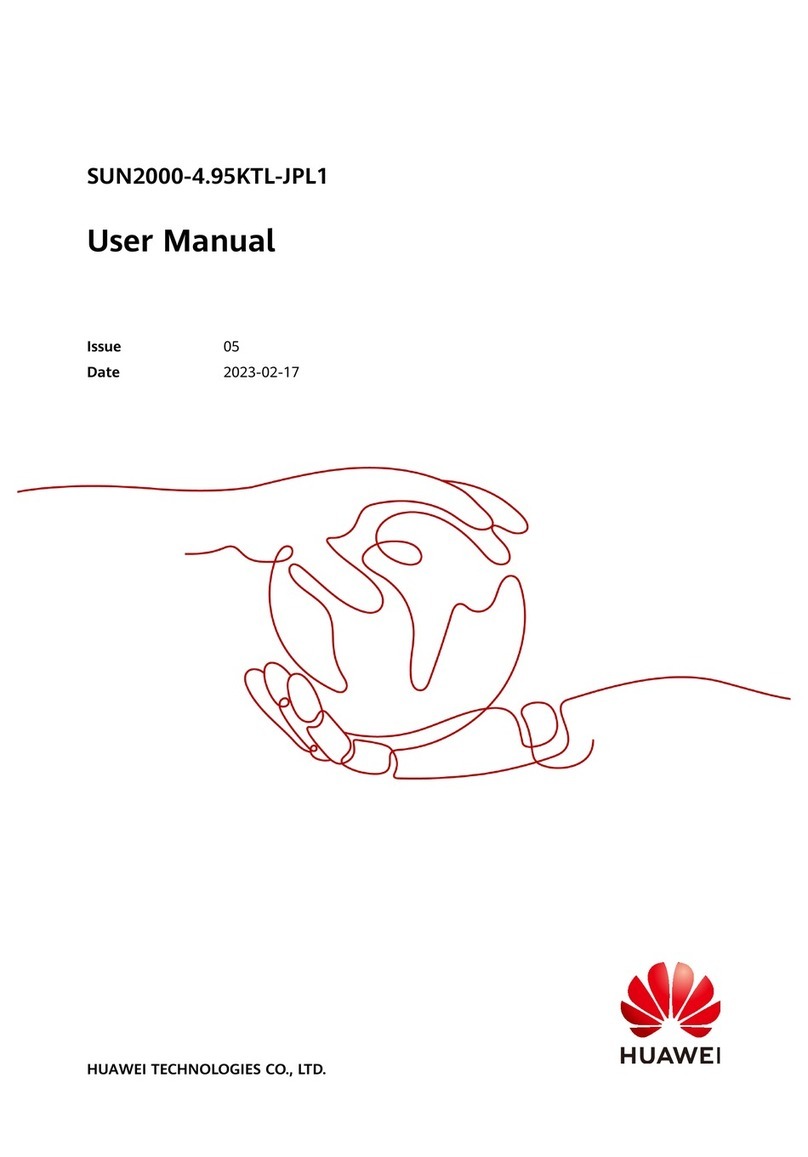
Huawei
Huawei SUN2000-4.95KTL-JPL1 user manual
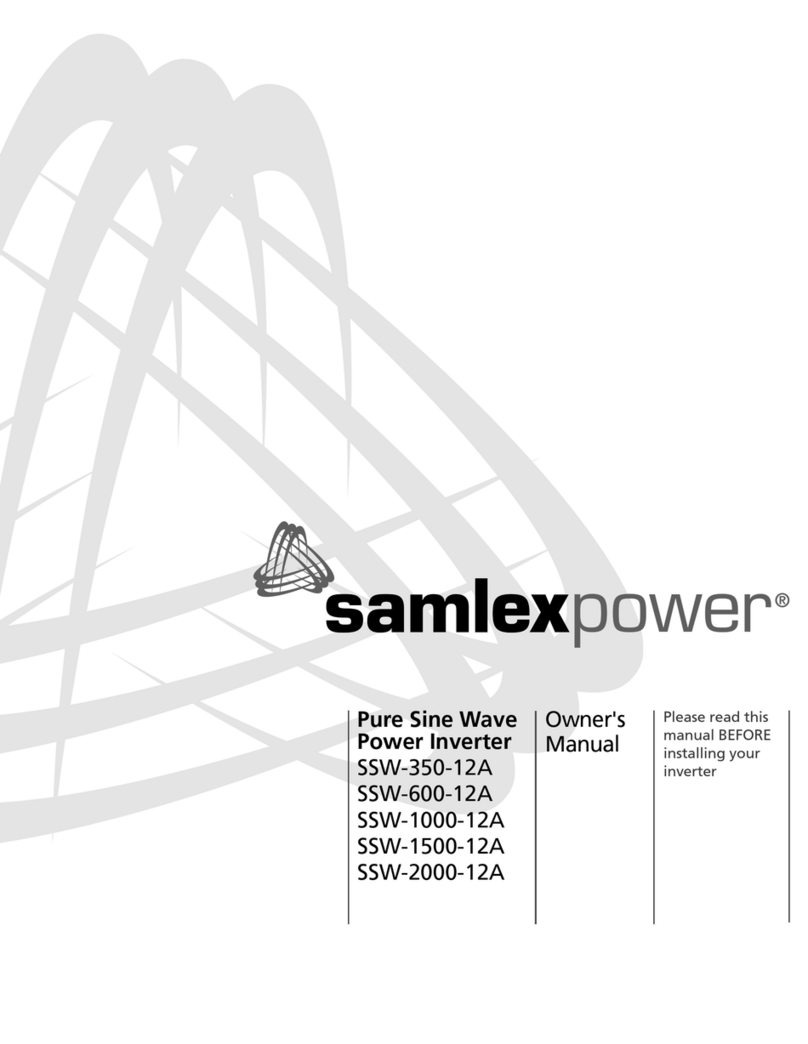
SamplexPower
SamplexPower SSW-350-12A owner's manual
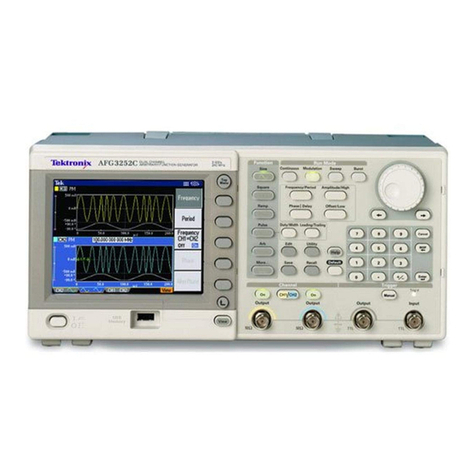
Tektronix
Tektronix AFG3011C instructions

Huawei
Huawei SUN2000-50KTL-NHM3 quick guide
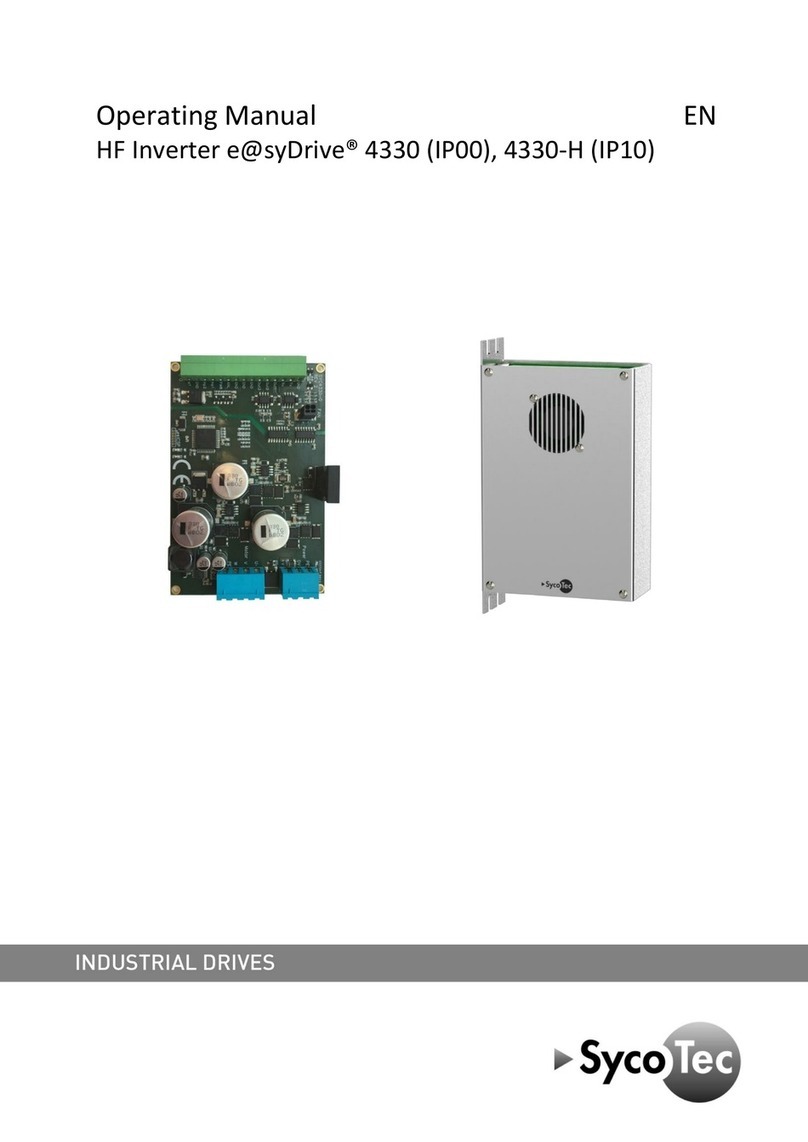
SycoTec
SycoTec easyDrive 4330 IP00 operating manual
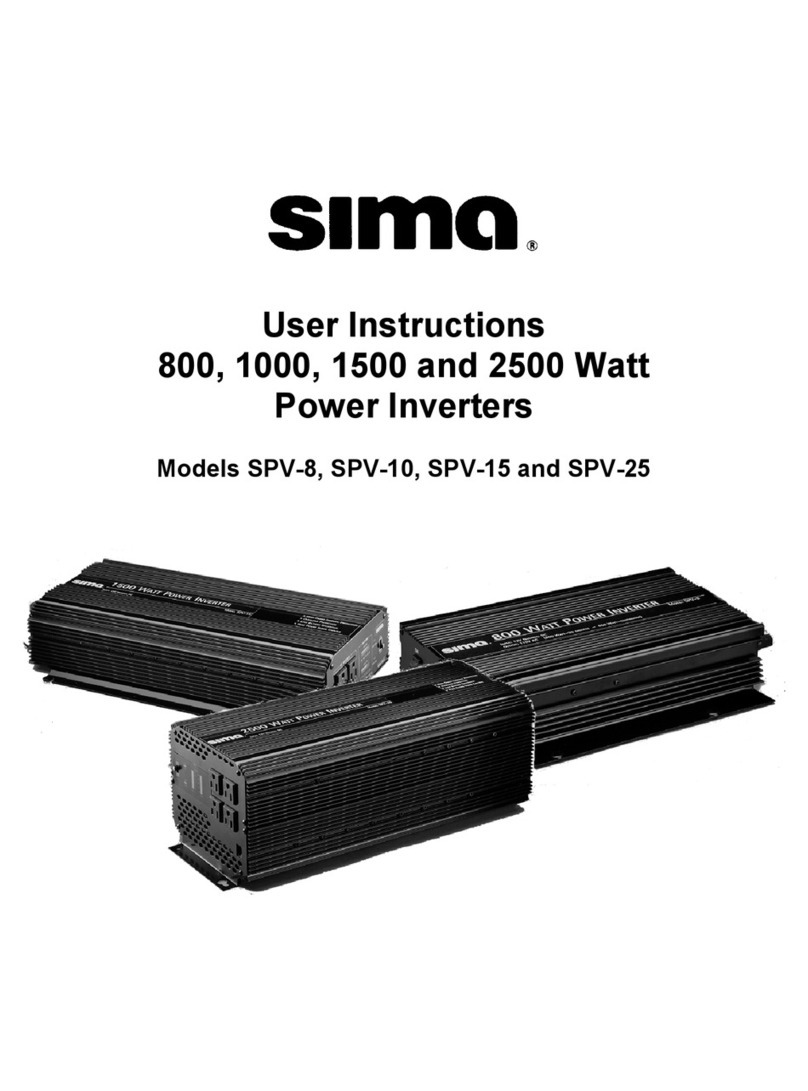
Sima
Sima SPV-8 User instructions
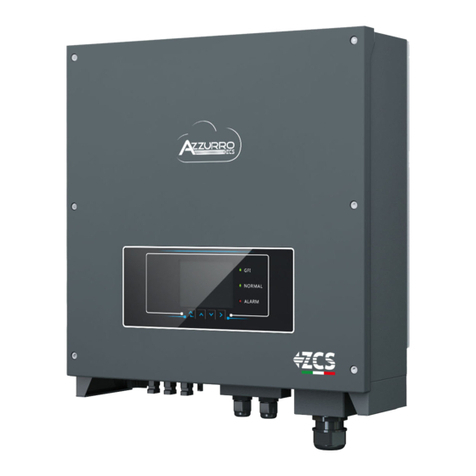
ZUCCHETTI
ZUCCHETTI 3PH 10KTL-15KTL-V2 user manual

Mosa
Mosa GE 7500 HBSLE - AVR Use and maintenance manual

Siemens
Siemens COMBIMASTER 411 Getting started guide
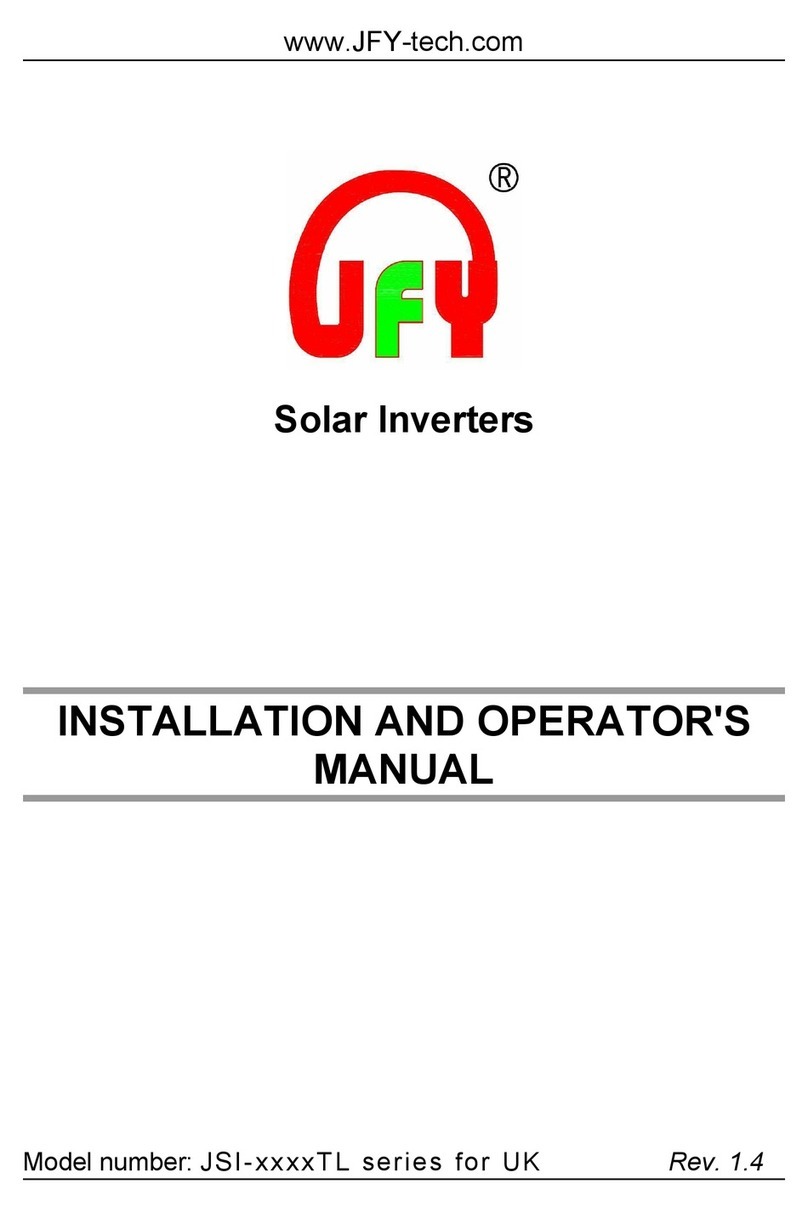
JFY tech
JFY tech JSI-1100TL Installation and operator's manual

